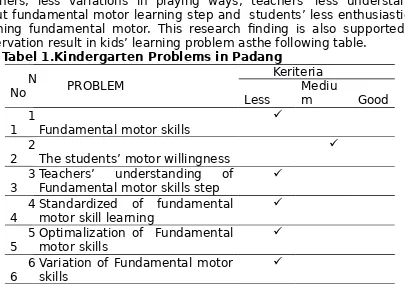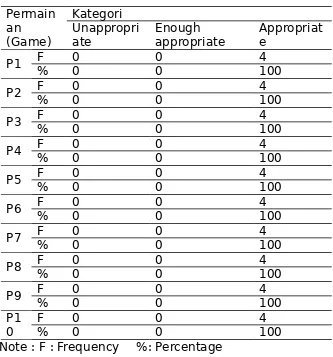DEVELOPMENT OF FUNDAMENTAL BASIC MOVEMENT SKILL OF CHILDREN
Yanuar Kiram1),
Anton Komaini2)
Nuridin Widya Pranoto3) 1)
Faculty of Sport Science, Universitas Negeri Padang Email: [email protected]
ABSTRACT
The aim of this study is to develop models of motor learning for kindergarten which adapts to the curriculum and characteristics of the students. This research used Research and Development method. Limited-scale trials were conducted on 20 kindergarten studentsin Padang Utara. Field trials were conducted on 35 students from two differents kindergarden. The instrument used to collect the data were general interviews instructions, field notes, evaluation sheet, scale validation questionaire, students assesment rubrics, game observation guideline, and game effectiveness observation guideline. Based on the data analysis it can be concluded that: (1) fundamental gross motor skill model for Kindergarten students in group A comprises of warming up activities, content proper and cooling down activities. (2) The model is arrange ina guide book entitled Games for Motor Skills (3) the gross motor learning model for kindergarten students is effective and is in accordance with the curriculum and characteristics of kindergarten children which can be used for learning gross motor skills
Keyword: Fundamental Motor Skills, kindergarten students
INTRODUCTION
Kids’ motor is interesting to be discussed, it is dominant for kids. The result of observation shown 70-80 % kids did the motor in their learning process through plaing approach. Kids are very active, then, motor and learning about motor is important. It should be the main attention too. The correct applying of motor will give the contribution into kids’ growth. Based on the explanation above, one of the important components to extend in education is the motor potency. Motor is defined as the person quality which can be improved by motor activity. The motoric development purposes to introduce and train the smooth and heavy motion.
Learning fundamental motor skill by learn through bodies activities which involve big muscles. It is also gain to improve kids’ physical potency in daily life activities. The learning process can be done by physical activities such as run or jump. Generally, the learning process is effectively done by playing (game). It is interesting for kids because it makes them relax and no pressure. According to Tedjasautra opinion (2001:17) playing is a happy activity. The kinds of playing must be suitable for kids’ ability and should give education. Unsuitable playing can give bad impact towards kids’ growth, physicaly or mentality.
Anton Komaini research in 2016 found some result about kids’ motion skill as follow; 5.06% students motor skill is in too little category, 13.92% is in less category, 22.15% is in middle category, 37.34% is in good category, and 21.15% is in good category. It means some of kids students are in low middle category. For example, there are students who cannot jump with their feet, catch ball without their hands, and cannot stand on kidtoes, cannot catch ball with hands, have no balance and cannot bounchback or roll the ball.
The problems are caused by some factors, such as less of school tools, less of learning model for basic motor, less understanding of teachers, less variations in playing ways, teachers’ less understaning about fundamental motor learning step and students’ less enthusiastic in learning fundamental motor. This research finding is also supported by observation result in kids’ learning problem asthe following table.
Tabel 1.Kindergarten Problems in Padang N
Teachers’ understanding of Fundamental motor skills step
4 4
Standardized of fundamental motor skill learning
found by the unsuitable achievement learning motor as the government is expected. The last but not list, the developing of learning model in fundamental motor skills is less of mximum. In fact, kinds of learning model are less of variations.
From the problems above, the researcher is get interest to give the solution through making leraning model of fundamental motor skills based on traditional game. Why the researcher bases in traditional game, the reason is to make easier in applying, more cheerful, and the important thing is to conserve the traditional game. It is culture heirloom which involves majesty values. The majesty values are reflected by the spirit and game philosophy (Jauhari, 2010:1). Traditional game is the game played by the kids in the past which use all tools and nature facilities. That’s why the researcher intends to research about “The Developing Students’ Motor Skills Model”
RESEARCH METHODOLOGY
The researcher uses the Development research. The procedures are; Sugiyono (2011:298) states some procedures in development research. It consists of some steps as follw: (1) knowing the potency and problem (2) data collecting (3) product design (4) validation design (5) revise design (6) product trial (7) product revise (8) usage trial (9) product revise. The population of the research is the students of Kindergarten in Padang district. Thie research is conducted in Samudra Kindergarten North Padan. The instrument of the research is fundamental motor skills test (Komaini: 2017)
RESULT AND DISCUSSION NecessarryAnalyzing
Necessary analysing is the way to extract the main problem through direct observation. In the research of learning fundamental motor skills, the analyzing is done to the kindergarten in north Padang. The observation done by some ways like interview towards students, teachers and parents, and also observed teaching learning process about fundamental motor skills directly.
Based on the observation can be conluded some information for instances, students feel bored with the games used in motor learning, the teacher difficulties in finding learning model for motor skills, less of learning model which is used nature as media.From the problems, the researcher will develop the learning model for motor skills in Kindergarten. The making process will be adjusted with curriculum, by then the students get easier in receiving lessons.
Description of Draf Product
The Data of Small Scale Trial
After the earlier draft getting validation, the next step to be done is small scale trial. In this research, the researcher tried in Samudra Kindergarten with 20 students whom taught by two teachers. There are three datas resulted from this reseach; (1) data of motor learning model observation in Kindergarten, (2) the data of result motor learning model observation in Kindergarten, (3) the data of suggestion for motor learning model observation in Kindergarten.
From this trial, there are ten questions are resulted which will be ask to the expert. In this questions therea re four different assessment scales. The data is processed by using Likert scale. The data validation and assessment frequency distributive as follow:
Tabel 1.The Distribution of Assesment Frequency by Expert and Teacher in every Game in Small Scale Trial
Permain an
(Game)
Unappropri ate
Enough Appropriate
Appropriat e
P1 F 0 0 3
% 0 0 100
P2 F 0 0 3
% 0 0 100
P3 F 0 0 3
% 0 0 100
P4 F 0 0 3
% 0 0 100
P5 F 0 0 3
% 0 0 100
P6 F 0 0 3
% 0 0 100
P7 F 0 0 3
% 0 0 100
P8 F 0 0 3
% 0 0 100
P9 F 0 0 3
% 0 0 100
P1 0
F 0 0 3
% 0 0 100
Note:
Based on the table found that the number of score in small scale trial is in interval 35 ≤X. Then, data is distributed to the assessment frequency. In the table, the score 35 ≤ X is in appropriate category. It means, the observer found that learning model of motor skills in Kindergarten is appropriate.
The Data of the Game Effectiveness in Small Scale Trial. Tabel 2
The Observation Result Data of the Game Effectiveness in Small Scale Trial
Expert and Teacher towards the Game Effectiveness in Small cale Trial
Formula Interval Category F %
The table shown that the total score given from three observers is in interval 35 ≤ X. it means in effective category. Theobservers (100%) assest the game for developing in small scale trial is effective to use in teaching learning process.
The Data of Wide Scale Trial
Tabel 4. The Distribution of Assesment Frequency by Expert and Teacher in every Game in Wide Scale Trial
Permain
Note : F : Frequency %: Percentage
Based on the table can be seen that the score in assessment wide scale trial is in 35 ≤X. The data distributed into assessment frequency. From the table of assessment distributive interval, score 35 ≤X is in appropriate category. It means, the observer state that motor learning model is appropriate with the students. The assessment of learning model effectiveness is processed by Likert with distance 1-4. The psikomotor effectiveness is the main to assest based on the Kindergarten curriculum. The Data of the Game Effectiveness in Wide Scale Trial.
Tabel 5
The Observation Result Data of the Game Effectiveness in Wide Scale Trial
G1
4 4 3 3 4 4 4 3 4 3
3 6 G2
4 4 3 3 4 4 4 3 4 4
3 7 Note:
A1: Expert 1 A2: Expert 2 G1: Teacher 1 G2: Teacher 2
Tabel 6
The Normative and Distributif Frequency Account of Assesment Category
Expert and Teacher towards the Game Effectiveness in WideScale Trial
Formula Interval Category F %
X < (μ-1,0σ) X < 25
Kurang Efektif
0 0
(μ-1,0σ) ≤ X < (μ+1,0σ)
25 ≤ X <
35 Cukup Efektif
0 0
(μ+1,0σ) ≤ X 35 ≤ X Efektif
4 10 0
Total
4 10 0
Note:
X: the total of subject score µ : mean ideal σ : standard of ideal devisiation
The tabel shown that the total score given by all observers is in 35 ≤ X. It means in effectivecategory. Allobservers(100%) concluded that the game in wide scale is effective to be applied.
CONCLUSION
Therea are some conclusion found from the research about the developing students’ motor skill model in Kindergarten.
1. The development of learning fundamental motor skills through animal game approach which use research and development method produce ten games as follow: (1) guess animal (2) snake finding food (3) running cheetah, (4) find animal, (5) take animal, (6) kangaroo jumping, (7) white egret jumping, (8) mouse hole, (9) cattle fish, (10) ant-lion.
2. The development of rough motor skill by adopting animal motor is effective to use in Kindergarten learning process.
3. The development of rough motor skill by adopting animal motor got the good respond from Kindergarten students.
SUGGESTION
The products of the research can be used for :
2. The Kindergarten teacher is suggested to use the learning model from the easy step to the complex step.
3. The tools used in applying learning model can be adjusted with school condition.
REFERENCE
A, Komaini, Fundamental Motor Skills of Kindergarten Students (A Survey Study of the Influence of Financial Condition, Playing Activity, and Nutritional Status). IOP Publishing. IOP Conf. Series: Materials Science and Engineering 180 (2017) 012156 doi:10.1088/1757-899X/180/1/012156
Allen, Eilee. Profil Perkembangan Anak. Jakarta. Erlangga, 2010.
Dale A, Alurich. (2000) Test of Gross Motor Development. Texas: Pro Ed Depdikbud, (1998) Permainan Tradisional Indonesia.Jakarta: Depdikbud Depdiknas, (2004) Model Latihan Jasmani (Jakarta:Depdiknas Pusat
pengembangan Kualitas Jasmani)
Gusril.(2009) Perkembangan Motorik Pada Masa Anak-Anak.Padang: UNP Press.
Gallahue, (2012) David L., Ozmun, John C dan Goodway, Jacqueline D.
Understanding Motor Development. New York: Mc Graw Hill,
Seventh Edition.
Kiram, Yanuar. (2000) Belajar Motorik.Padang: FIK UNP.
Rusman. (2011). Model-model pembelajaran: mengembangkan
profesionalisme guru. Jakarta: PT Raja Grafindo Persada.
Rahmawati, Eka (2010) Bermain Asyik Permainan Tradisional. Jakarta: Multi Kreasi satudelapan.
Rakhimawati. (2003) Buletin Pembelajaran Universitas Negeri Padang (Pelaksanaan Kurikulum Taman Kanak-Kanak di Kecamatan Padang
Utara). Padang: UNP Press.
Samsudin. Pembelajaran Motorik di Taman Kanak-Kanak. Jakarta: Prenada Media Group, 2008.
Sugiyanto.(2008).Model-model pembelajarn inovativ. Bandung: Alfabeta Sugiyono. (2011). Metode penelitian kuantitatif kualitatif dan R&D.
Bandung: Alfabeta.
Sujiono, Y.N. (2009). Konsep dasar pendidikan anak usia dini, Jakarta: Indeks
Tedjasaputra, M. (2001).Bermain mainan dan permainan. Jakarta: Gramedia.


